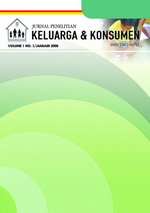FAKTOR-FAKTOR PENENTU PENGAMBILAN KEPUTUSAN PEMILIHAN MAYOR MAHASISWA S1 TAHUN AKADEMIK 2005/2006
Abstract
In determining major choosing, students as consumers were influenced by internal and external factors. The aimed of this research was to study the determinant factors in decision making of undergraduate students academic
year 2005/2006. The research was conducted in Bogor Agricultural University (IPB) Dramaga, Bogor since May to November 2006 by using one time cross sectional study. Sampling technique used was stratified random sampling with 331 samples. Data were collected by using questionnaire as a guide. Most of samples had determined their major since they entered IPB. Alumni job prospect was the first information they looked when read major’s information. For most samples, open house and promotion activities in Graduate Square influenced their major decision making. In addition, self interest (66.6%) and alumni job prospect (53.2%) influenced major decision making. This time, most samples (61.9%) had first major choosing and according to them the major suited their desire (74.0%). Logistic regression showed that samples with cumulative grade index > 2.75 had opportunity 3.5 times to obtain major suited to their desire compare with samples with cumulative grade index < 2.75. Major determine based on self interest had opportunity 1.467 times to obtain major suit to their desire compare with samples not based on self interest. The active seeking information samples had opportunity 1.489 times to obtain major suited their desire compare with passive seeking information samples.
Authors submitting manuscripts should understand and agree that copyright of manuscripts published are held Jurnal Ilmu Keluarga dan Konsumen. The statement to release the copyright to Jurnal Ilmu Keluarga dan Konsumen is stated in Copyright Release Form. Copyright encompass exclusive rights to reproduce, to distribute, and to sell any part of the journal articles in all form and media. The reproduction of any part of this journal is allowed with a written permission from Jurnal Ilmu Keluarga dan Konsumen.









